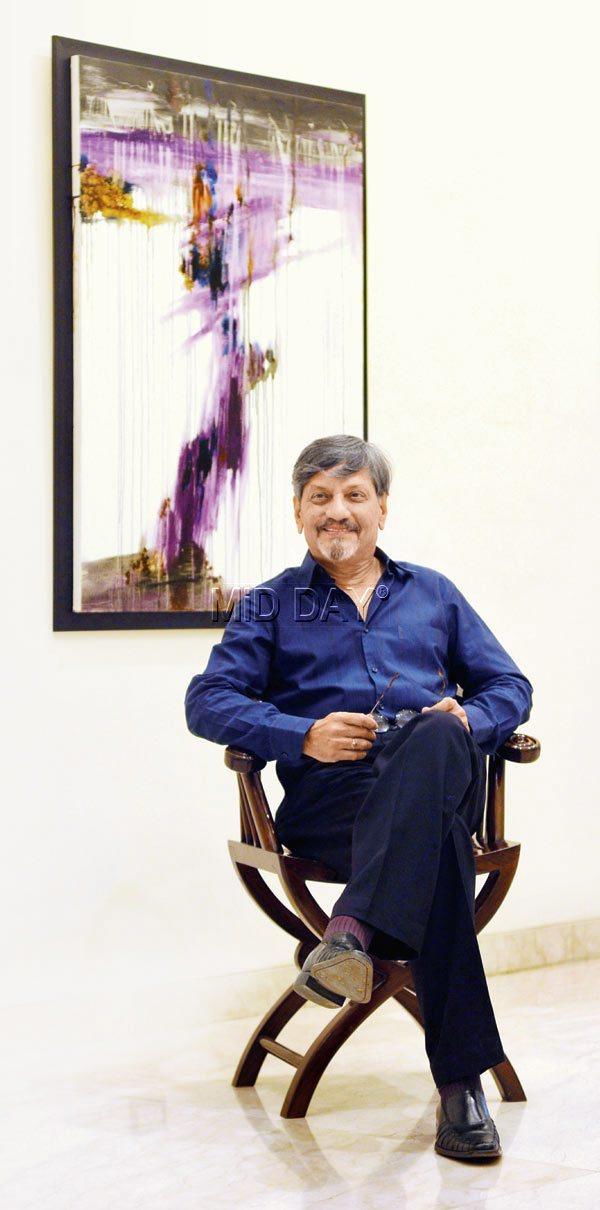Kareena Gianani meets the actor-filmmaker before his solo art exhibition and finds out what his art means to him at 70, and his quest for silence

Amol Palekar
At Worli’s Gallery Art & Soul, veteran actor, director and artist Amol Palekar patiently gauges the space that will exhibit more than 30 abstract paintings November 26 onward. The exhibition coincides with Palekar’s 70th birthday. Excerpts from an interview:
ADVERTISEMENT

Amol Palekar with one of his paintings at Gallery Art & Soul at Worli. Pic/Satyajit Desai
Q. Do you think your acting career overshadowed your art?
A. Yes, but that isn’t surprising, is it? Performing arts is a journey toward and with the spectator; art is an introverted journey.
Q. But you never stopped painting.
A. No. At every point in life, I ensured that two of three things I love doing — art, theatre and films — are robust. I branched out to book design when Gulzarsaab approached me to design the book cover of his book, Rabi Paar. I also created art for a book by Kishor Kadam, a Marathi poet who wrote under the pseudonym, Soumitra, whom I greatly admire. But it is only one-and-a-half years ago that I really began taking stock of myself as an artist and painting more seriously.
Q. How does that frame of mind set this exhibition apart, then?
A. At my age, it is natural to get introspective and take account of one’s life, and I am no exception. With this exhibition, I found what I am happiest with. For instance, I wake up every morning with the thought of an unfinished painting, and an answer to how I will finish it, because I seem to have worked it out in my sleep! That never happened to me before.
Q. So, what is your deepest preoccupation as an artist now?
A. Silence.
Q. Silence?
A. Yes, pauses. You know, even in theatre, silence fascinated me more than the spoken word. I found it more eloquent. Like in literature, subtext is infinitely more interesting than declaration. When I was a young actor, I always wondered how long and well I could hold a long pause onstage — how I could make the most of my craft sans superfluous dialogue. Now, I am also exploring my space anew with my art. When you’re young, you want to prove yourself to the world. But now, all these years later something Sir John Gielgud said makes more sense. He once wrote how, when a young swimmer takes to water, he wants to show his strokes off. But later, all one wants is to float without creating a ripple.
Q. How has your art influenced your acting, and vice versa?
A. It was mostly the former more than the latter. When I began acting, productions by the likes of the National School of Drama were larger than life, and, in contrast, Marathi theatre looked artistically quite poor. The abstract painter in me wanted to rebel against both, and I tried to build more suggestive sets using black and grey. I also felt compelled to use the actors’ bodies to convey meaning as much as dialogue could. When I began making films, I tried to push the visual aspect in my filmmaking. For instance, to be able to shoot my Marathi film, Anahat (2003) inside a temple’s complex in Hampi after sunset, I coaxed the Archeological Survey Of India for a year. As I filmed the climax at its famed stepwell, I first imagined the scene as a painting.
Q. You were taught by Shankar Palsikar, Baburao Sadvelkar and Sambhaji Kadam at the JJ School of Art. Tell us about your inspirations.
A. I was lucky to have been taught by them. As an artist, I am fascinated with Amedeo Modigliani. Among Indian artists, Vasudeo Gaitonde will always remain an inspiration — I can walk miles to see his works. I am inspired by the way he dealt with silence in his paintings, and few artists have his command over art.
Q. What is next for you, especially in art?
A. I don’t know. I am thoroughly enjoying this state of being a painter — the smell of turpentine, linseed oil and paint. I am also enjoying the fears and apprehensions of an artist, especially the terrifying blank canvas. For this show, I ordered a canvas larger than anything I have worked on, and I stood in front of it for a week, terrified. I want to soak these feelings in. Who knows, in five years, I might exhibit a retrospective of my works.
 Subscribe today by clicking the link and stay updated with the latest news!" Click here!
Subscribe today by clicking the link and stay updated with the latest news!" Click here!






